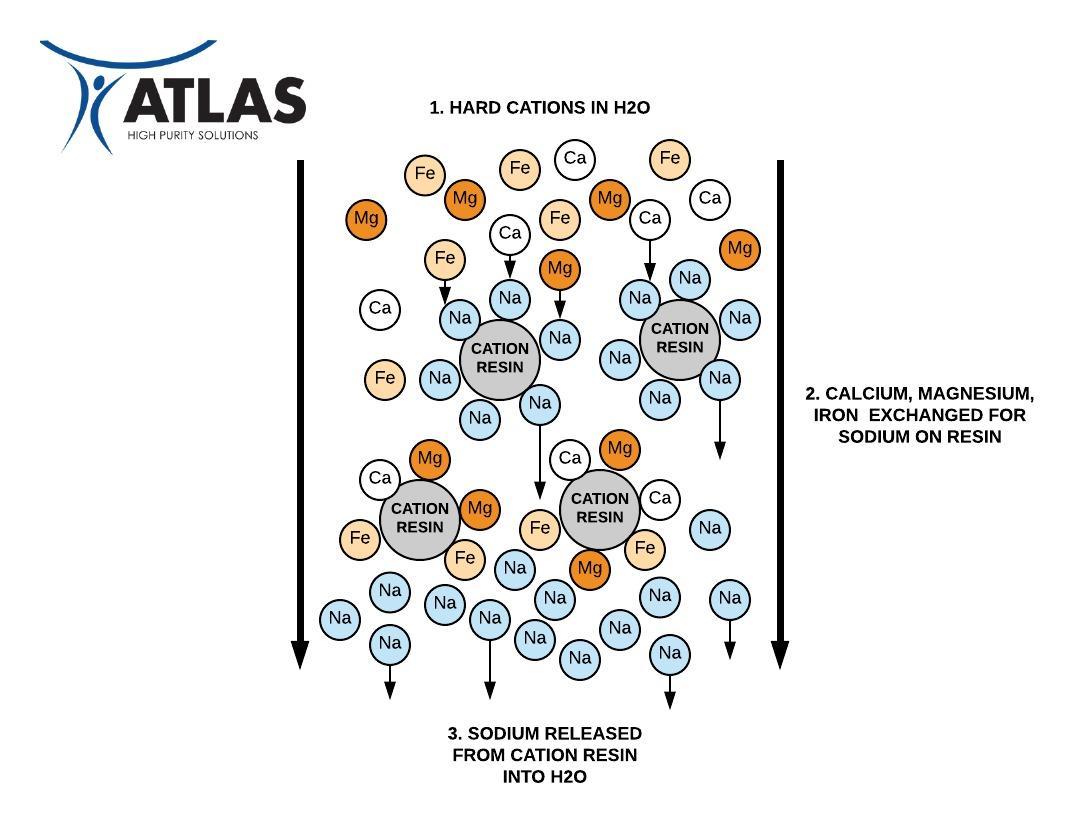Pretreatment for reverse osmosis (RO) is a critical component of any high purity water system design.
The vast majority of reverse osmosis (RO) performance issues can be traced to improper pretreatment design. Therefore, the utmost care must be taken in analyzing feed water conditions and matching these conditions with the appropriate pretreatment technologies. This article serves as an overview of several common pretreatment technologies used in high purity water system design.
In most high purity water systems, pretreatment serves to "prepare" water for the RO stage(s). The primary functions of an effective pretreatment system for RO feed are:
A) Removal of sediment and suspended solids
B) Removal of hardness (namely calcium, iron, and magnesium)
C) Removal of chlorine and chloramines
D) Removal of bacteria, TOC, and organics (depending on final water quality requirements)
A) Sediment Removal
A variety of technologies are available for sediment (suspended solids) removal, turbidity and silt density index (SDI) reduction.
For "low flow" systems -- i.e. <= ~2 gallons per minute (GPM) of RO permeate flow -- cartridge filtration is an effective solution for sediment (suspended solids) removal. Filter housings are typically loaded with either 10 micron or 5 micron nominal filters sized to 3 gallons per minute (GPM) per 10 inch equivalent for 2.5” diameter filters. Larger diameter filters can be used as well. In many systems we utilize a filter that combines nominally rated filtration with carbon in order to remove both chlorine/chloramines and sediment in one solution. AmeriWater portable dialysis systems and healthcare RO systems utilize this technology. For smaller high purity water systems, Suez cartridge filters (Hytrex, AquaTrex) are our preferred solution.
For higher flow rate systems -- i.e. >= ~3 GPM of RO permeate flow -- or systems with higher sediment loads, multimedia filters are effective for sediment (suspended solids) removal, turbidity, and silt density index (SDI) reduction. Multimedia filters consist of various medias including sand, anthracite, and gravel, loaded into an FRP or steel backwashing tank. The primary advantage of a multimedia filter is its ability to backwash and send captured sediment to drain. As a result, multimedia filtration media has a long lifespan (we typically recommend re-bedding a multimedia filter every 7-10 years unless conditions dictate otherwise). The downside of multimedia filtration is higher water usage, as these units require substantial amounts of water to backwash. Multimedia filters can remove sediment down to 10 microns, though some manufacturers claim to offer systems reducing sediment down to 1 micron.
Another common pretreatment technology is a backwashing cartridge filter. These filters utilize a nominally rated screen (10 microns down to 1 micron in some instances) and backwash to remove trapped sediment from the screen and flush it to drain. Backwashing cartridge filters are typically used for higher flow systems with moderate to low sediment. It’s a versatile technology that offers numerous advantages over multimedia filtration including smaller size, lower water usage, and lower total cost of ownership. Atlas and Pure Flow partner with Forsta Filters to offer a wide variety of backwashing cartridge filter technologies for high purity water pretreatment, building filtration (point of entry/"POE" filtration systems), and other applications.
Ultrafiltration (UF) is a very effective pretreatment technology for RO pretreatment. Due to cost, UF is typically used for high flow (100 GPM+) high purity water applications, or instances where reduction of a specific contaminant in a feed source is critical for RO performance. We partner with Suez Water to design UF systems utilizing the Suez ZeeWeed product line.
B) Hardness Reduction
Hardness reduction is a critical function of RO pretreatment and aids in the prevention of RO membrane fouling. Under the pressures of the RO process, hardness ions easily drop out of solution and can scale the RO membranes. For most RO system designs, we aim for less than 3 grains per gallon (GPG) of hardness before feeding an RO unit.
The two primary technologies used to reduce hardness are 1) water softeners and 2) antiscalants.
Water softeners utilize sodium-form cation resin to remove hardness: namely calcium, magnesium, and iron. As hard water passes through a softener, these ions are exchanged for the sodium on the cation resin. Over time, the cation resin will become exhausted and a regeneration is required. Softener regeneration is a process whereby salt (as a brine solution) is drawn into the water softener to regenerate the cation resin with sodium. Once the cation resin is overwhelmed with sodium, the hardness (iron, calcium, magnesium, etc) is released from the resin and removed during the regeneration and backwash cycle. Water softener regenerations can be initiated by either a time setting or a water usage setting. We commonly use duplex or triplex softener configurations where constant flow is required. Simplex water softeners with an RO lockout feature prevent hardwater bypass to RO during a regeneration. Atlas and Pure Flow partner with ResinTech for cation resin supply in our softeners.
Antiscalant can be an effective tool for combating RO membrane fouling caused to hardness and other contaminants. The antiscalant is typically injected upstream of the RO unit and is designed to keep potential foulants in solution. A capability of antiscalants, but not of water softeners, is the prevention of scaling from certain other common foulants such as silica. As a result, some pretreatment designs include both antiscalant feed and water softeners.
Figure 1: Cation exchange process for water softening

C) Dechlorination
Removal of chlorine and/or chloramine is a critical consideration of any RO pretreatment design. Chlorine is highly detrimental to RO membranes and chlorine breakthrough should be avoided in order to prevent RO membrane failure. Most polyamide RO membranes are rated to 1,000 PPM hours of chlorine tolerance. A well-designed RO and RO pretreatment maintenance program will ensure the greatest longevity for the RO membrane elements, which are often the most expensive consumable component of a high purity water system.
The two prominent technologies for chlorine/chloramine removal are carbon filtration and sodium bisulfite feed.
Carbon filters come in several formats. For low flow systems (<= ~2 GPM of RO permeate flow) carbon cartridge filters (commonly called “carbon block filters”) can be used to remove chlorine at certain concentrations. These filters double as sediment removers for low flow systems as well. Some examples of equipment utilizing this type of filtration include the AmeriWater portable dialysis and low flow central sterile product lines.
Exchange carbon tanks (non-backwashing) are commonly used for low flow systems, though backwashing tanks typically yield better economic results over the long-term.
Carbon tanks need to be re-bed periodically, as carbon becomes exhausted and loses its ability to remove chlorine/chloramines. We typically recommend proactively re-bedding on an annual basis or monitoring chlorine levels daily to ensure chlorine breakthrough is prevented.
For most higher flow RO applications (>= ~3 GPM of RO permeate flow), backwashing carbon filters are a common element of pretreatment design. Backwashing carbon filters include automated valve heads designed to trigger a backwash based on flow totals or time of day. For 24/7 operation, we use duplex or triplex tank configurations to ensure constant availability of the RO unit during a backwash cycle.
For general applications, carbon tanks filled with granular activated carbon (GAC) are sized for between 3 and 5 minutes of empty bed contact time (EBCT – defined as [Bed Volume (CUFT) x 7.48 (Gallons/CUFT) ] / Flow Rate (GPM). Per AAMI requirements, dialysis water systems require duplex carbon tanks configured in series with 10 minutes total EBCT per tank. Carbon tank design must take the chlorine levels of the feed water source into consideration to ensure sufficient dechlorination.
Finally, carbon is also effective for removing organics in feed sources. However, this is less concerning for systems where RO is part of the design and can remove those contaminants later on in the process.
For more information on pretreatment design, feel free to reach out to one of our representatives.
___
Atlas High Purity Solutions has been designing, installing, and servicing high purity water systems for more than thirty years, and is the leading provider of reverse osmosis and DI water solutions in the northeast United States.



